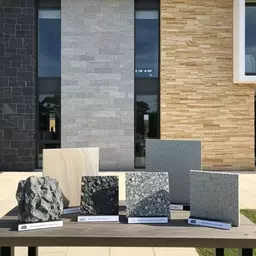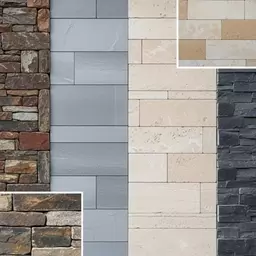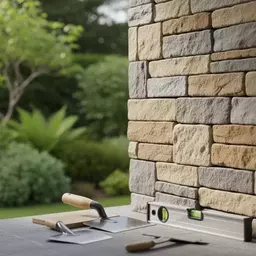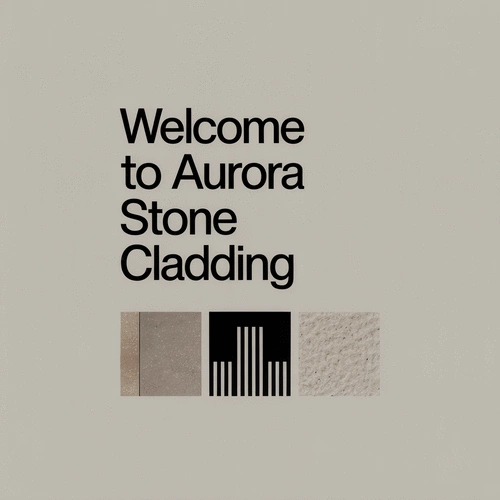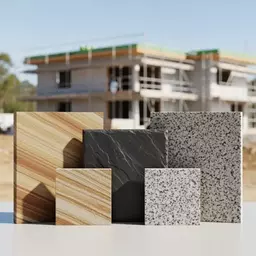What if your home could make a statement not just about style but also about sustainability? By choosing eco-friendly stone cladding, you're embracing an aesthetic that speaks to both beauty and environmental responsibility. Let's uncover the vital lessons on sustainable stone cladding that you can apply to your next project.
What You Will Learn
- Eco-friendly stone cladding utilizes sustainable extraction methods, minimizing environmental impact.
- Incorporating recycled and reclaimed materials enhances the sustainability of your stone cladding project.
- Choosing locally quarried stones reduces carbon footprints and supports local economies.
- Understanding compliance with AS 4214 standards ensures safety and enhances the longevity of your cladding installation.
- Look for reputable sustainability certifications to verify the eco-friendliness of stone products and suppliers.
Key Aspects of Sustainable Stone Sourcing and Best Practices
This visual highlights the crucial elements involved in eco-friendly stone cladding, from material evaluation to sustainable sourcing practices, alongside best practices for implementation.
Evaluating Material Characteristics
- Longevity & resistance to wear
- Ease of maintenance
- Thermal properties for energy efficiency
- Natural beauty & uniqueness
Compliance with Australian Standards
Adherence to AS 4214 standards ensures safety, performance, and longevity in mechanical fixing and installation. Crucial for durable and reliable facades.
Sustainable Certification Programs
- Green Building Council of Australia
- Cradle to Cradle certification
- Global Reporting Initiative (GRI)
Best Practices for Eco-Friendly Cladding
- Choose locally sourced materials
- Evaluate sustainability certifications
- Utilize natural stone
- Engage with reliable suppliers
- Implement energy-efficient installation
Understanding Sustainable Stone Cladding in Australia
When we talk about sustainable stone cladding, we’re diving into a topic that's not just about aesthetics, but also about protecting our planet! At Aurora Stone Cladding, we believe that choosing eco-friendly options reflects a commitment to both beauty and environmental responsibility. So, what exactly makes stone cladding eco-friendly? Let’s explore the materials and processes involved.

Eco-friendly stone cladding typically includes natural stones that have been quarried with minimal environmental impact or engineered stones produced sustainably. The extraction methods should prioritize reducing harm to the local ecosystem, employing techniques that protect surrounding habitats while minimizing waste. Additionally, using recycled materials or reclaimed stones can further enhance sustainability, so it's great to consider these options when planning your next project! For a deeper dive into the distinctions, read about natural vs. engineered stone cladding.
Defining Eco-Friendly Stone Cladding
- Utilizes sustainable extraction methods
- Incorporates recycled and reclaimed materials
- Prioritizes low emissions during production
- Promotes durability and longevity
In essence, eco-friendly stone cladding is about creating beautiful spaces that don't compromise our environment. Imagine your home wrapped in a stunning façade that not only elevates its charm but also stands as a testament to your commitment to sustainability!
Importance of Sustainable Sourcing Practices
Sourcing stone sustainably is crucial for maintaining the integrity of our environment. When we opt for responsibly sourced materials, we’re helping to ensure that the ecosystems from which these stones originate remain protected. Choosing locally quarried and reclaimed stone not only reduces the carbon footprint associated with transportation but also supports local economies.

At Aurora Stone Cladding, we advocate for understanding where materials come from. It’s not just about aesthetics; it’s about making informed choices that benefit both our communities and our planet. By embracing sustainable practices, we can create architectural finishes that are as kind to the earth as they are beautiful to behold! You can learn more about sourcing sustainable stone cladding materials to ensure your project aligns with eco-friendly goals.
Key Aspects of Sustainable Stone Sourcing
Evaluating Material Characteristics
When choosing stone for your project, evaluating the material characteristics is essential. Natural stone, in particular, boasts numerous benefits; its durability means it can withstand the test of time, while its aesthetic appeal adds an element of elegance that can transform any space.
Consider these qualities when assessing materials:
- Longevity and resistance to wear
- Ease of maintenance
- Thermal properties that contribute to energy efficiency
- Natural beauty and uniqueness of each stone
By selecting materials that embody these traits, we ensure that our projects not only look stunning but also hold up beautifully over the years!
Compliance with Australian Standards
Understanding the relevance of AS 4214 standards for mechanical fixing and installation is vital for any stone cladding project. These standards ensure that the installation process meets safety and performance criteria, which ultimately leads to a more durable and reliable façade.
Adhering to these standards can prevent future issues and enhance the longevity of your cladding system. It’s worth discussing these requirements with your contractor to ensure that all aspects of the installation are up to code!
Understanding Certification Programs for Sustainable Stone
There are several certification programs that can help you verify the sustainability of stone products and suppliers. These certifications serve as a guide in selecting materials that align with your eco-friendly goals. Look for certifications that focus on the sourcing, production practices, and lifecycle of the stone materials.
- Green Building Council of Australia certifications
- Cradle to Cradle certification
- Global Reporting Initiative (GRI) standards
By choosing certified products, you can confidently ensure that your stone cladding choices align with your commitment to sustainability. It’s a win-win for both your project and the planet!
Interactive Poll: Your Thoughts on Sustainable Stone Cladding
We'd love to hear from you! What aspect of sustainable stone cladding resonates most with you? Choose one of the options below:
Summary of Best Practices for Eco-Friendly Stone Cladding
As we delve into the world of sustainable stone cladding, it's crucial to recap the key points discussed about sourcing and installation in Australia. Ensuring that your stone cladding choices are environmentally friendly not only enhances the beauty of your space but also contributes positively to the planet! Here’s a quick overview of best practices:
- Choose locally sourced materials: Reducing transportation emissions is vital.
- Evaluate sustainability certifications: Look for reputable programs that validate eco-friendly practices.
- Utilize natural stone whenever possible: Its durability and low maintenance contribute to a longer lifecycle.
- Engage with reliable suppliers: Building relationships with trustworthy vendors can ensure sustainable practices.
- Implement energy-efficient installation methods: This not only minimizes waste but also enhances your building's performance.
By keeping these best practices in mind, we can all play a part in fostering a more sustainable construction industry. Sustainable stone cladding is not just a trend; it's a commitment to our environment that will yield beautiful results for generations to come.
Encouraging Sustainable Choices in Stone Cladding
As we wrap up our discussion on eco-friendly stone cladding, I want to encourage you to take a moment to consider the impact of your choices. At Aurora Stone Cladding, we are passionate about promoting materials that are both stunning and sustainable. By opting for sustainable stone options, you’re not just enhancing your home or project but also contributing to a greener future!
Connecting with suppliers who prioritize eco-friendly practices can lead to incredible results. Consider asking questions such as:
- What sustainability certifications do your products have?
- Can you provide information on the sourcing of your stone?
- What kind of maintenance is required to keep the stone in optimal condition?
By choosing wisely, you’re making an investment in your space and the planet. Let's work together to create beautiful, sustainable environments that we can all be proud of! For more details on maintaining your eco-friendly investment, explore natural stone cladding care tips.
Recap of Key Points
Here is a quick recap of the important points discussed in the article:
- Choose locally sourced materials: Reducing transportation emissions is vital.
- Evaluate sustainability certifications: Look for reputable programs that validate eco-friendly practices.
- Utilize natural stone whenever possible: Its durability and low maintenance contribute to a longer lifecycle.
- Engage with reliable suppliers: Building relationships with trustworthy vendors can ensure sustainable practices.
- Implement energy-efficient installation methods: This not only minimizes waste but also enhances your building's performance.
Frequently Asked Questions About Sustainable Stone Cladding
What makes stone cladding "eco-friendly"?
Eco-friendly stone cladding involves using natural stones quarried with minimal environmental impact, incorporating recycled or reclaimed materials, and ensuring low emissions during production. The practices prioritize protecting local ecosystems and minimizing waste.
Why is sustainable sourcing important for stone cladding?
Sustainable sourcing ensures that the environment from which stones are extracted remains protected. It reduces the carbon footprint associated with transportation by prioritizing local materials and supports local economies. It's about making informed choices that benefit both communities and the planet.
What are the key material characteristics to consider for sustainable stone cladding?
Important characteristics include longevity and resistance to wear, ease of maintenance, thermal properties for energy efficiency, and the natural beauty and uniqueness of each stone. These qualities ensure the project is both aesthetically pleasing and durable.
How do Australian Standards (AS 4214) relate to sustainable stone cladding?
AS 4214 standards are crucial for ensuring the safety, performance, and longevity of stone cladding installations, particularly concerning mechanical fixing. Adhering to these standards helps prevent future issues and ensures a durable, reliable facade, aligning with the long-term sustainability goals of a project.
What certification programs should I look for to verify sustainable stone products?
Reputable certification programs include those from the Green Building Council of Australia, Cradle to Cradle certification, and Global Reporting Initiative (GRI) standards. These programs help verify the sustainability of stone products and their suppliers, covering sourcing, production practices, and the lifecycle of materials.


